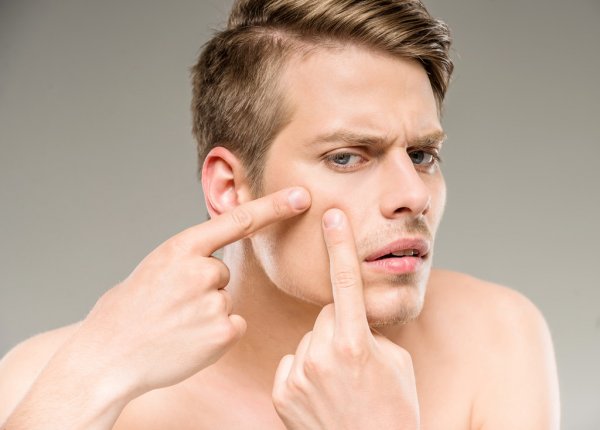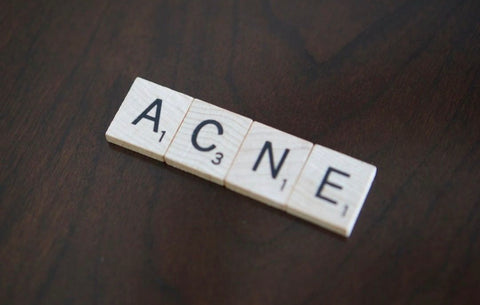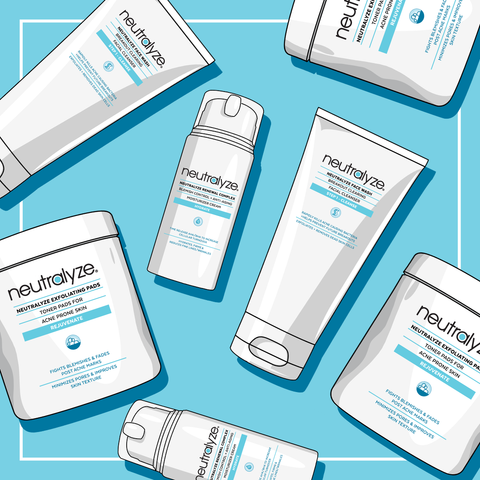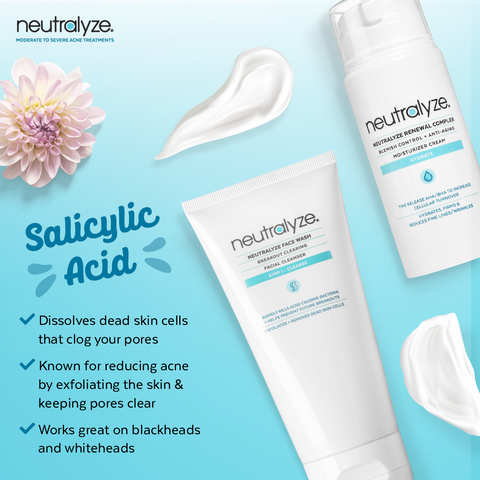Men’s Guide to Dealing with Acne

Acne is a problem that many people encounter well beyond their teenage years. In fact, up to 55% of adults between the ages of 20 and 40 experience acne problems. Acne remains the most common skin condition in the US, affecting approximately 50 million Americans every year.
While both men and women are affected by this, acne behaves differently between the two sexes. This is due to biological factors on top of the normal causes of acne. Because of this, the steps that men have to take to combat this skin condition differ from those taken by women.
Gentlemen, if you’re dealing with a persistent pimple problem or experiencing your first acne breakout post-puberty, then worry not. In this article, we’re going to take a look at the types of acne you may experience as an adult and the best ways to deal with them.
What Is Adult Acne?
Adult acne refers to any form of acne that appears on a person over 25 years old.
At its core, adult acne is the same as any other type of acne. The idea that acne is exclusive to teenagers experiencing puberty is a common misconception. People can experience any form of acne regardless of age. It’s just that some age brackets experience it more than others.
However, adult acne has some unique properties. They can be signs of an underlying condition affecting the endocrine system, such as Cushing’s syndrome or polycystic ovarian syndrome. Such diseases that are related with the overproduction of hormones can have acne as one of their symptoms.
Of course, this doesn’t mean that every acne breakout you may experience past the age of 25 leads to serious diseases. The same factors that cause adolescent acne are still at play even as you grow past your teenage years.
What Causes Acne in Men?
The main cause of acne is the clogging of pores. Clogging can occur either because of hormonal changes or external factors.
Inside the pores under your skin are hair follicles containing sebaceous glands that produce sebum, a natural oil that keeps your skin moisturized. Sebum is secreted outwards from these glands and onto the surface of your skin through hair protruding from your pores. If your pores get blocked, sebum is trapped inside.
Clogged pores can cause sebum to accumulate along with dead skin cells and hair, creating acne. The involvement of bacteria can cause acne to grow in severity. The clogged pore becomes inflamed and pimples appear.
Fine particles and pollutants can clog your pores from the outside, while hormonal changes create clogs from inside your body.
Sex Hormones
Hormones are the main reason why puberty is linked to acne. Teenagers undergoing puberty experience increased hormone levels that cause the oil glands in their skin to go on overdrive. This causes the glands to produce excessive amounts of sebum, which clogs pores and forms acne.
The same thing can happen to adults.
In men, testosterone can cause acne outbreaks for the same reason. While this hormone is primarily meant to drive the development of male qualities like a deeper voice and larger muscles, it can also cause excessive sebum production.
Androgen is another hormone that can cause adult acne in men. High androgen levels also cause increased sebum production. This hormone is present in both men and women. However, men have a larger volume of androgen when compared to women because women’s bodies convert it into estrogen.
While testosterone production in men is at its highest during puberty, it gradually slows down with age, so expect fewer testosterone-induced acne breakouts as you pass the age of 30.
Stress and Cortisol
Stress is another factor that’s connected to acne breakouts in both men and women. This is due to a steroid hormone called cortisol.
Cortisol can control your mood and fuels your natural fight-or-flight response when faced with danger. Cortisol can also regulate your blood pressure, carbohydrate consumption, and boost your energy when needed.
When your body experiences physical, mental, or emotional stress, your adrenal glands produce high amounts of cortisol to prepare you for whatever challenge lies ahead.
Cortisol doesn’t directly cause acne. However, high cortisol levels caused by stress can lead to a series of events that eventually cause an acne breakout.
Stress can result in increased hormone levels that can cause sebaceous glands to rapidly produce oil, causing acne to form.
Certain stressful conditions can also trigger specific skin-related reactions on your body. Sleep deprivation, for example, can place your brain under a lot of stress and cause your skin to dry up. This forces your body to produce more sebaceous oil to keep the skin moisturized, which can lead to acne formation.
Additionally, studies show that high cortisol levels can slow down the healing of acne and wounds in general. Existing acne can end up worsening if you’re under constant stress.
Certain Types of Food
Some types of food are known to cause acne because of how they affect our body’s stress level and chemical makeup. Eating food that’s difficult to digest causes physical stress.
Consuming food that you are personally sensitive to may also cause acne breakouts. Your body recognizes it as a threat, triggering an immune response. This response is called a delayed hypersensitivity reaction and can lead to inflammation, which can lead to acne.
On the other hand, preliminary studies have deemed certain food types to be objectively more likely to cause acne breakouts. Food containing refined carbohydrates like bread, pasta, white noodles, and sugar-sweetened beverages has been linked to acne formation.
Such food can increase your insulin and blood sugar levels, which can make your body produce skin cells more rapidly. This excessive formation of skin cells can cause clogs in your pores.
Types of Acne
The kinds of acne that can affect adult men remain the same as with any other demographic. Acne is primarily divided into two categories: non-inflammatory and inflammatory acne. Here’s a brief overview on each type:
Non-Inflammatory
Non-inflammatory acne refers to clogged pores with no bacterial presence. This type of acne manifests in the form of comedones, which are more commonly known as whiteheads and blackheads. Apart from their color, whiteheads and blackheads are differentiated based on whether the affected pore is open or closed.
A whitehead is a type of non-inflammatory acne with a closed pore. A thin layer of skin covers the affected pore, giving them their characteristic white or skin-colored look.
On the other hand, a blackhead is a form of blemish inside an open pore. Contrary to the belief that blackheads are black because of dirt, they are actually dark in color because the material forming the clog turns black as it makes contact with oxygen.
While non-inflammatory acne is not as bad as other acne types, they can turn into full-blown pimples if left unchecked.
Inflammatory
Inflammatory acne is more prominent than non-inflammatory ones. They are larger and more painful, and they often take longer to heal than a whitehead or blackhead. They normally form as pustules or papules, while the more severe cases manifest as nodules and cysts.
Pustules are more widely known as the common pimple. When bacteria infect a clogged pore, inflammation ensues. Your body then sends white blood cells to try and fight the infection, which causes pus to build up.
Papules are small, reddish bumps that are also caused by bacterial infection. They are painful to the touch unlike non-inflammatory acne, and they’re essentially the same as pustules but without the pus buildup.
Pustules and papules usually heal over time, taking up to a few days before disappearing completely. Because of this, they’re considered mild inflammatory acne.
Nodules and cysts, on the other hand, are more serious. When bacterial infections reach deep within your skin, either of these two may form.
Cysts appear as large bumps similar to pimples. They are tender or painful to the touch and are filled with pus. Meanwhile, nodules are more severe versions of papules. Like cysts, they grow underneath the skin and can cause intense pain. They can persist for weeks, and clusters of nodules can form around an area. They appear as skin-tone colored bumps, but they can also appear red as swelling intensifies.
Treatment and Care
While there may be plenty of methods and products designed to combat acne, keep in mind that the best acne treatment for men completely depends on the kind of acne you’re experiencing. Different scenarios require different solutions, but there are some strategies that experts generally recommend.
Practice Good Hygiene
Maintaining proper hygiene is a good way to prevent adult acne from breaking out. Wash your face at least twice a day and shower regularly to keep your body clean and pores unclogged.
Avoid Popping Pimples
If you have pimples around your mouth or beard line, be extra careful not to pop them as you shave. Popping pimples can cause the surrounding pores to be clogged with pus, essentially spreading the pimple. This can result in a more painful pimple cluster than what you started with.
Try Over-the-Counter Topical Solutions
If you have acne on your face or other parts of your body, you may want to consider looking into acne treatment for men. Over-the-counter solutions can treat existing non-severe forms of acne. Ointments or acne creams for men that have ingredients like benzoyl-peroxide are good options to consider.
Seek Professional Care
If you’re having trouble getting rid of acne, a dermatologist will be able to pinpoint the cause and give you treatments with lasting results. Doctor appointments are also your best bet at dealing with severe acne like nodules or cysts.
The type of treatment your doctor may recommend can vary depending on your age and the severity of your acne. In most mild cases, you can expect to receive some prescription medication, but if you have severe acne, you may have to undergo physical treatments, which may be performed in conjunction with topical or oral medication.
Topical Medication
Topical medication like anti-acne retinoids can prevent your hair follicles from getting clogged, preventing the formation of acne at its roots. These may be accompanied by topical antibiotics that will eliminate skin bacteria and reduce swelling.
Oral Medication
There are also different kinds of oral medication. Moderate to severe acne may be treated with oral antibiotics together with topical retinoids. This will minimize the odds of acne formation by preventing follicles from clogging, killing bacteria, and reducing inflammation, although oral antibiotics may also result in side effects like dizziness and increased skin sensitivity.
Isotretinoin is another powerful drug that’s very effective against severe acne. However, it poses more risk than oral antibiotics as it can cause severe side effects like ulcerative colitis and chemical imbalance that may lead to depression.
Light-Based Treatments
Light-based therapy has seen some success in treating acne, but results may vary from person to person. Multiple treatments may also be required to maximize the effect.
Steroid Injections
Steroid injections can also be used to treat severe cysts and nodules to great effect. These injections can trigger rapid healing of the affected areas.


